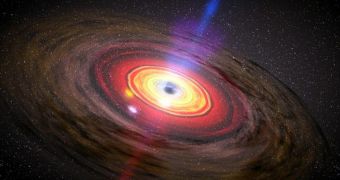Black holes have such extreme gravitational fields that anything falling beyond the event horizon is ultimately destined to hit the point-like singularity, where it will probably remain forever. Believe it or not, but stable orbits around black holes are possible. Just because an object has extreme gravitational fields, it does not necessarily mean that matter in its close vicinity will fall towards it, thus approaching the black hole at the right speed and angle may put you in an orbit. Anything but that, and you would fall towards the black hole or be ejected from the system through a so-called gravitational key-hole.
New calculations regarding interactions between a black hole's gravitational field and photon particles reveal that photons could orbit black holes as well, one or more times before being ejected from the system. This causes powerful light bursts to appear in a stroboscope flash-like fashion, which can be used to calculate the exact properties of a black hole, such as mass and rotation period.
Stable orbits for photons are unavailable, as for any orbiting object. It all depends on the time scale. Even artificial satellites orbiting around the Earth do not have stable orbits. Meaning that sooner or later their trajectories will eventually decay and suffer one of the resulting consequences of such processes. In fact, our Moon had a much closer orbit to Earth than it is currently being observed.
Light pulses emitted by black holes are caused by the X-ray emissions originating in the accretion disks spinning around the black holes. The light is scattered in all directions, thus a part of the light to be emitted towards the black hole. Depending on the angle of attach, a part will be absorbed by the black hole, while the other part will be bent around it.
Occasionally, some light particles may even complete orbits around it. Again, the number of orbits greatly depends on the angle of the light beam related to the black hole's event horizon. The more orbits a photon particle completes, the greater the delay between the original light beam emitted from the accretion disk and that of the light flash resulted when the photon escapes from the orbit around the black hole is.
The Theory of General Relativity predicts that rapidly spinning black holes could, in fact, rotate the fabric of space, dragging it around. This effectively means that more photons would have trajectories that would take them in orbits around the black hole, thus enabling more light to be emitted during the process of orbit decay, providing with increased chance in detecting such emissions from distant locations in space.
The delay introduced between the original light emitted from the accretion disk and the emission from the black hole basically provides with information regarding the mass of the black hole, and possibly even its rotation speed.
However, not everything is as easy as it sounds, considering that the effect is just a particularity of the black holes. Usually, the black holes or quasars are surrounded by massive accretion disks, hiding the event horizon completely. This means that, even if the original light emitted by the disk of matter is being observed, the chance for an observer to actually see the echo from the black hole is close to zero, as it would most likely be reabsorbed in the accretion disk.
Secondly, the conditions for such events are fearsome. The original flare must be aiming precisely towards the observer, the emitted particle must enter in an orbit around the black hole and, last but not least, the emission from the black hole must by pointed towards the observer as well, in order to detect the delay between the two.
Astronomers agree: such observations would require pure chance. Nevertheless, pulsating objects such as Quasi Periodic Oscillations have been reported in the near vicinity of black holes, but the delays between the light emissions are just too long to be associated with black holes.
Keigo Fukumura from NASA's Goddard Space Flight Center, argues that future discoveries of X-ray emission averaging more than 1000 periods per second would be an irrefutable evidence of light being bent all the way around a black hole.

 14 DAY TRIAL //
14 DAY TRIAL //